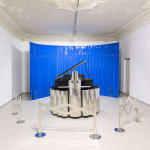Julijonas Urbonas Lithuanian, b. 1981
A Planet of People , 2017-2019
Mišri technika / Mixed media
Further images
A Planet of People (2017 - 2019) is an artistic and scientific feasibility study of an artificial planet made entirely from human bodies. The project revolves around the idea of...
A Planet of People (2017 - 2019) is an artistic and scientific feasibility study of an artificial planet made entirely from human bodies.
The project revolves around the idea of sending humans to L2, one of the Lagrangian points in space where the gravity is absent, and allows the frozen bodies float freely until their weak gravities make them assemble into a blob: in this way, a new ‘human’ planet is extra-terraformed. A cosmic fossil of humanity. A monument of humans to humans.
Playing with its variables, such as the quantity of individuals and the duration of time, the project speculates upon the aesthetic, ethical and scientific aspects of such a space structure. What spatial structures would it be possible to choreograph? How would a landscape of biomass look like on such a planet? What biochemical processes would it undergo, and would it form its own ecosystem eventually? And what would be the ethical, cultural and political implications, both here on Earth and out there?
The project questions the very (anthropocentric and earthly) definition of human species and life in general – its aesthetic and ethical implications – by looking into how the discourse changes once a large group of human bodies cross the Kármán line which marks the border between our ecosystem and outer space. Combining astroanthropology, speculative engineering, biomechanics, space law, space medicine, astrophysics, astrogeology and space arts, the project also speculates upon the establishment of exo-disciplinary arts.
The outcomes of the artistic research are visualised through 3D astrophysics simulations, 3D human body scanner based interactive installation, drawings and performances.
Extraterrestrial design and architecture: Julijonas Urbonas
Astrophysics: Vidas Dobrovolskas
3D simulation, programming, animation: Jakob Schloetter (Pointer Studio), Ignas Pavliukevičius
Music: Gailė Griciūtė
Graphic design: Asya Sukhorukova (Pointer Studio)
Electronics: Dmitrij Snegin
Industrial electronics: Vladas Kaškonas
Technical assistance: Paulius Vitkauskas
The exhibition was supported by the Ministry of Culture of the Republic of Lithuania, Lithuanian Council for Culture, Vilnius City Municipality, Science Gallery Dublin, Vilnius Academy of Arts, Clear Channel, Vilma Dagilienė, Romas Kinka, Lietuvos Rytas, Ekskomisarų biuras.
The project revolves around the idea of sending humans to L2, one of the Lagrangian points in space where the gravity is absent, and allows the frozen bodies float freely until their weak gravities make them assemble into a blob: in this way, a new ‘human’ planet is extra-terraformed. A cosmic fossil of humanity. A monument of humans to humans.
Playing with its variables, such as the quantity of individuals and the duration of time, the project speculates upon the aesthetic, ethical and scientific aspects of such a space structure. What spatial structures would it be possible to choreograph? How would a landscape of biomass look like on such a planet? What biochemical processes would it undergo, and would it form its own ecosystem eventually? And what would be the ethical, cultural and political implications, both here on Earth and out there?
The project questions the very (anthropocentric and earthly) definition of human species and life in general – its aesthetic and ethical implications – by looking into how the discourse changes once a large group of human bodies cross the Kármán line which marks the border between our ecosystem and outer space. Combining astroanthropology, speculative engineering, biomechanics, space law, space medicine, astrophysics, astrogeology and space arts, the project also speculates upon the establishment of exo-disciplinary arts.
The outcomes of the artistic research are visualised through 3D astrophysics simulations, 3D human body scanner based interactive installation, drawings and performances.
Extraterrestrial design and architecture: Julijonas Urbonas
Astrophysics: Vidas Dobrovolskas
3D simulation, programming, animation: Jakob Schloetter (Pointer Studio), Ignas Pavliukevičius
Music: Gailė Griciūtė
Graphic design: Asya Sukhorukova (Pointer Studio)
Electronics: Dmitrij Snegin
Industrial electronics: Vladas Kaškonas
Technical assistance: Paulius Vitkauskas
The exhibition was supported by the Ministry of Culture of the Republic of Lithuania, Lithuanian Council for Culture, Vilnius City Municipality, Science Gallery Dublin, Vilnius Academy of Arts, Clear Channel, Vilma Dagilienė, Romas Kinka, Lietuvos Rytas, Ekskomisarų biuras.






